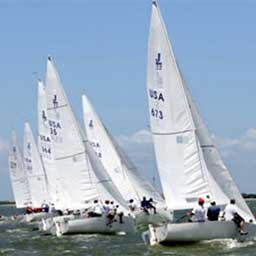The Bareboat Cruising graduate will have successfully demonstrated the ability to skipper and crew an inboard auxiliary powered cruising sailboat within sight of land and bring it safely to anchor during daylight hours.
Recommended Equipment: It is recommended that Bareboat Cruising courses and examinations be conducted on 30′ to 45′ sloop-rigged cruising keelboats with wheel steering and auxiliary diesel power, and with adequate equipment inventory to complete all required certification outcomes.
Prerequisite: The prerequisite for Bareboat Cruising Certification is a US Sailing Basic Cruising Certification.
Certification Requirements: Bareboat Cruising Certification requires the successful completion of the following knowledge and skill requirements. These requirements are expected to be able to be performed safely with confident command of the boat with a wind of at least 15 knots.
Practical Skills
Preparation to Sail:
- Obtain an appropriate weather forecast for your cruise and plan accordingly.
- Check the sail inventory and select the appropriate sails for the conditions.
- Check the location and condition or operation of all safety equipment.
- Describe the need to be aware of and perform checks of the engine fluids and mechanical parts, manual and electric bilge pumps, and the electrical, mechanical, freshwater, marine head and holding tank systems. *updated 5.2.2019
- Perform a complete check and demonstrate safe use of the galley stove and stove fuel system.
- Ensure that all necessary provisions, cooking and eating utensils are aboard and properly stowed.
- Check the security and operation of all hatches, ports and companionways.
- Inventory and check the condition of all bimini tops, cockpit awnings and dodgers where applicable.
- Inventory and check the condition of all tools and spare parts.
- Check the condition of dinghy and oars (and outboard, if applicable).
11. Inventory and check the condition of all required charts, tide tables, cruising guides, and navigation tools. - Perform a complete inspection of all deck gear: standing and running rigging, lifelines, stanchions, and pulpits.
- Understand your responsibilities and liabilities as a bareboat charter customer according to your contract with your charter company.
Crew Operations and Skills:
- Demonstrate a comprehensive crew briefing and plan of responsibilities.
- Demonstrate the operation of the emergency steering equipment.
Leaving the Dock or Mooring:
- Demonstrate the proper lashing of a dinghy on deck or securing it for towing.
- Demonstrate appropriate helmsman and crew coordination and the skills necessary for leaving under power in any wind condition.
Navigation:
- Demonstrate your ability to: correctly use a hand-bearing compass and a ship’s compass; maintain a proper DR plot with time/speed/distance calculations; work up an estimated position; plot a fix using lines of position and/or ranges; use depth sounder; use accepted plotting and labeling techniques; understand buoyage systems and aids to navigation; identify and correlate visual observations and landmarks with chart symbols.
- Use a GPS chart plotter to plan and sail a multi-leg route.
Heavy Weather Sailing:
- Demonstrate shortening sail to depower, and explain effects on balancing the boat.
- Demonstrate heaving-to.
Overboard Rescue Methods:
- Properly demonstrate one of the overboard rescue methods under sail, which is most appropriate for: your sailing ability, boat type, crew experience, wind and sea conditions, and maintaining constant visual contact with the person in the water.
- Demonstrate an overboard recovery method under power which allows you to maintain visual contact with the person in the water.
Anchoring Techniques:
- Select an anchorage and demonstrate appropriate helmsman and crew coordination and the skills necessary to anchor with two anchors under power using one of the following methods: bow and stern, two anchors off the bow at 60°, or two anchors off the bow at 180° (Bahamian Moor).
- Pick up a mooring.
- Demonstrate appropriate helmsman and crew coordination and the skills necessary to recover your anchor under power.
Returning to the Dock or Mooring:
- Demonstrate appropriate helmsman and crew coordination and the skills necessary for returning to the dock under power in any wind direction.
Securing the Boat Properly:
- Demonstrate the correct procedure for returning the charter boat in the same condition that it was chartered, and complete a charter check-in report on the condition of the boat.
Knowledge
Preparation to Sail:
- Understand bareboat charter procedures and responsibilities for both the charter company and the charter client.
- Determine the vessel’s fuel capacity, fuel consumption, and cruising range under power.
- Be familiar with the documentation required for the vessel and crew both nationally and internationally.
- Be familiar with the legal responsibilities of a skipper and the courtesies to be observed when entering a foreign port.
- Understand the legal responsibilities of the overboard discharge of pollutants.
- Understand all federal, state and local regulations as they pertain to your boat.
- Be familiar with all required documentation for crew and vessel nationally and internationally.
Crew Operations and Skills:
- Be familiar with proper rafting techniques at docks and at anchor.
Navigation:
- Understand how to: use tide and tidal current; use the rule of twelfths, and apply set and drift and anticipated leeway when determining a course to steer. *updated 5.2.2019
- Understand IALA Systems A and B, including cardinal marks.
- Be familiar with the considerations, responsibilities and special techniques required for navigation in restricted visibility.
- Understand the meaning of the visual observations of watercolor.
- Be familiar with the benefits and limitations of cruising guides.
- Understand Automatic Identification System (AIS).
- Understand the limitations and potential dangers of electronic navigation.
Heavy Weather Sailing:
- Describe the signs of an approaching squall and the actions to be taken.
- Describe the desired orientation of the boat to the waves when heaving to.*updated 5.2.2019
Overboard Rescue Methods:
- Be familiar with the equipment provided for overboard rescue.
- Understand procedures for overboard rescue in a larger cruising boat in unfamiliar waters and with a crew that you might not sail with regularly. Understand the Quick-Stop, Lifesling-type and Figure-8 overboard rescue methods under sail to include: constant visual contact with the person in the water, communications, recovery plan, sequence of maneuvers, boathandling, course sailed, pickup approach, and coming alongside the person in water (or simulated object).
- Describe methods of getting an overboard recovery person in water back on deck after the vessel is stopped alongside.
- Explain when overboard rescue should be done under power and the inherent dangers.
Safety and Emergency Procedures:
- Giving due consideration to the state of the tide, describe a plan of action if you run aground in moderate conditions.
- Describe a plan of action if your vessel has: a broken thru-hull; been holed; an engine failure; a steering failure.
Anchoring Techniques:
- Describe the procedures for anchoring with two anchors.
- Describe the use of a tripline/anchor buoy.
- Describe the procedures for clearing fouled anchor rodes, and for recovering an anchor from under another boat.
- Describe the procedures for dealing with a dragging anchor.
- Describe the advantages and disadvantages of the following anchoring methods: bow and stern, two anchors off the bow at 60°, two anchors off the bow at 180° (Bahamian Moor), and Mediterranean moor. Returning to the Dock or Mooring.
- Describe the precautions when docking under sail.
Securing the Boat Properly:
- Describe the responsibilities of the charter client and the charter company when returning the boat.






